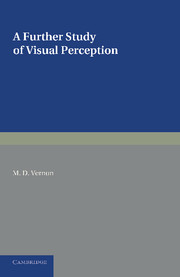Book contents
- Frontmatter
- Contents
- List of Illustrations
- Acknowledgements
- Chapter I INTRODUCTION
- Chapter II THE NATURE OF PERCEPTION
- Chapter III THE PERCEPTUAL PROCESS
- Chapter IV THE DETERMINATION OF FORM
- Chapter V SPATIAL PERCEPTION
- Chapter VI THE CONSTANCIES
- Chapter VII THE FUNCTIONS OF THE FRAMEWORK IN PSYCHO-PHYSICAL EXPERIMENTS
- Chapter VIII THE PERCEPTION OF MOVEMENT
- Chapter IX MICHOTTE'S STUDIES OF SOME INTRINSIC PHENOMENA OF EXPERIENCE
- Chapter X THE INFLUENCE OF INTERNAL AND INDIVIDUAL FACTORS UPON PERCEPTION
- Chapter XI CONCLUSION
- Appendix A
- Appendix B
- References
- Index of Authors
- Index of Subjects
Chapter II - THE NATURE OF PERCEPTION
Published online by Cambridge University Press: 05 June 2016
- Frontmatter
- Contents
- List of Illustrations
- Acknowledgements
- Chapter I INTRODUCTION
- Chapter II THE NATURE OF PERCEPTION
- Chapter III THE PERCEPTUAL PROCESS
- Chapter IV THE DETERMINATION OF FORM
- Chapter V SPATIAL PERCEPTION
- Chapter VI THE CONSTANCIES
- Chapter VII THE FUNCTIONS OF THE FRAMEWORK IN PSYCHO-PHYSICAL EXPERIMENTS
- Chapter VIII THE PERCEPTION OF MOVEMENT
- Chapter IX MICHOTTE'S STUDIES OF SOME INTRINSIC PHENOMENA OF EXPERIENCE
- Chapter X THE INFLUENCE OF INTERNAL AND INDIVIDUAL FACTORS UPON PERCEPTION
- Chapter XI CONCLUSION
- Appendix A
- Appendix B
- References
- Index of Authors
- Index of Subjects
Summary
If we consider carefully the nature of our perceptual experience of the world around us, we cannot fail to be impressed by the coherence in space and time of that experience; and equally by its extreme diversity. There is a combination and integration of sensations from the different sense organs; a stability and persistence of percepts produced by sensations constantly changing in quality and quantity; and a continuity, both spatial and temporal, of these percepts. Nevertheless, this continuity and stability are not that of a featureless mass, but of an environment consisting of objects clearly demarcated from each other, each possessing its characteristic and recognizable appearance and behaviour.
In our contacts with the external world, certain material objects or certain wave formations of energy impinge upon the various parts of the body surface. In general, these impacts differ in extensity, intensity, duration, and frequency. The sense organs in the sensitive areas respond characteristically, and transmit nerve impulses to the central nervous system which are also differentiated in virtue of their frequency and numerousness; by differences in rate of rise and fall resulting from the sensitivity and adaptation of the sense organ; and by the nerve paths along which they travel and the cortical areas upon which they impinge. Thus it might be concluded that, so far as the receptor areas of the cortex were concerned, the external environment would be supposed to consist of a mass of sight, sound, taste, smell, touch, pain, heat and cold, pressure, joint and muscle sensations, each differentiated more or less accurately in intensity, extensity, localization, and duration; and also in certain qualities such as colour, pitch, etc., which were peculiar to the type of sense organ stimulated. Clearly then there has been a very considerable transformation in the nature of the impressions as they pass from the sense organs to the receptor areas of the cortex. The nature of the environment which they would appear to indicate is utterly different from that which we in fact experience. We know that we receive stimuli from the external world which vary continually in intensity, extensity, and duration.
- Type
- Chapter
- Information
- A Further Study of Visual Perception , pp. 6 - 18Publisher: Cambridge University PressPrint publication year: 2013



